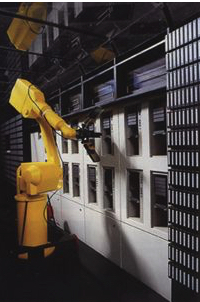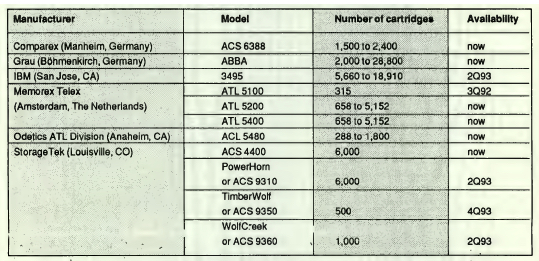History (1992): First IBM 3490 Cartridge Library
Too big or too late?
By Jean Jacques Maleval | June 16, 2020 at 2:19 pmAfter many hesitations and lots of trouble, IBM finally unveiled its own automated 3490 cartridge library, that can store up to 45TB in a huge unit 28m long.
Storage Technology or STK (Boulder, CO), the undeniable leader in this sector, with at least 90% of the market, does not seem to worry.
Among a range of new products and software on DFSMS, AdStaR (Advanced Storage and Retrieval), an IBM company headquartered in San Jose, CA, gave out some specs of their own cartridge library, the 3495. It is a lengthwise configuration, with shelves that can hold 5,660 to 18,910 3490 cartridges depending on the model (L20, L30, L40 and L50, from the smallest to the largest), with a non IBM six-axis robot that can automatically insert media in 4 to 64, 18 or 36-track cartridge drives.

This robot could come from General Motors-Fanuc GMF and used in the automotive industry. Each cartridge can store up to 800MB on its new long version tape recently developed by 3M, and close to 2.4GB by using IBM’s IDRC data compression system, which means a total capacity of 45TB for the entire library.
The machine measures 12 to 28m long and 2.4m wide. In the best case, it can operate 200 loading/unloading cartridge cycles per hour.
The 3495 is only intended for ES/9000 processors under MVS and afterwards for VM/ESA and AIX/ESA environments.
The complete availability is scheduled for the 2Q93 at prices starting at $393,000 and reaching $851,000.
The machine will be mounted in Valencia, Spain) for Europe and in San Jose, CA for the US.
It is not planned to be sold to OEMs neither to be developed in other configurations else than IBM’s, unlike what StorageTek does.
The first unit will be received this month by Sears Roebuck and Co., who devised the system in cooperation with IBM.
STK had already reacted at IBM 3495 first with its PowerHorn (or ACS 9310), with the same capacity as the ACS 4400, 6,000 cartridges, but with robotics that performs twice as fast, which means 350 cartridge exchanges per hour.
Current ACS 4400 can be upgraded for $150,000, a new unit costing $305,000, plus $20,000 per drive.
In the 70’s, Big Blue had offered the first cartridge library using helical scan recording technology, the 3850, and had sold a half thousand of them before it stopped making them on account of low reliability.
On its own side, in January 1987, STK launched its ACS4400 automated tape library that became a big success since the Colorado firm is just about to celebrate its 4,400th installation in the world.
The first model, less spacious, with a 3.35m diameter can only hold a maximum of 6,000 cartridges, but can allow extra communicating silos.
“We’re mostly targeting STK sites that have more than one silo,” said Alain Viguie, in charge of IBM’s French enterprise and storage systems marketing division in Paris.
Inside IBM, just like everywhere else, everyone agrees that Big Blue made a marketing mistake by never believing in the success of the lucrative tape library market. The number one tried to change its aim, but clumsily, and signed agreements with German manufacturers Grau and Haushahn, before this late announcement.
Additionally, for the first time, sales of STK libraries in these last months stabilized. Is the market saturated? “No,” answers Michel Oddou, ahead of library products for STK’s French subsidiary. “IBM’s announcement and the economic crisis slowed down acquiring decisions. Only 20% of large accounts and Fortune 500s are equipped.”
According to Freeman Associates, the WW revenues of all tape library products grew from $646 million in 1990 to $843 million in 1991. But IBM will still have to prove that its 3495, lately announced and that is only aimed at the high-end market, is not another marketing mistake.

This article is an abstract of news published on the former paper version of Computer Data Storage Newsletter on issue ≠53, published on June 1992.













 Subscribe to our free daily newsletter
Subscribe to our free daily newsletter

